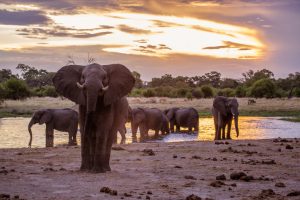With populations of elephants and rhinos declining alarmingly throughout Africa because of poaching, habitat loss, and conflict with humans, Botswana has become one of Africa’s most important sanctuaries in the battle for conservation.
Over the past years, Botswana has emerged as one of the jewels of Southern Africa. Its diverse ecosystems and beautiful landscapes are home to some of the rarest wildlife on the planet. It is no wonder that it is regularly called a must-visit safari destination.
To preserve this natural heritage, Botswana has long been engaged in environmental preservation, with almost 45% of its land being protected. This is most evident at the Linyanti Wildlife Sanctuary along the Chobe River which borders neighbouring Namibia.
Also read: 11 Reasons to visit Botswana this year

The Namibian side is often filled with elephant carcasses, killed by hunters and poachers. While on the other bank, some 80,000 elephants emerge each evening to drink and bathe in the river. This startling contrast illustrates Botswana’s commitment to the prevention of such slaughter and poaching.
The country has also been successful in rebuilding its rhino populations after the species was almost eradicated. In 2001, the country’s government started a militaristic anti-poaching unit that has worked hard to protect these species.
Sustainable Tourism Helps Botswana Grow
However, none of this would have been possible without a thriving partnership between government and tourism. Both are conscientious and passionate about protecting the country’s environment, making the growth of Botswana’s iconic wildlife a possibility.

Its anti-poaching unit has often been called a game-changer. Unlike countries such as South Africa which rely on the private sector to deal with poaching, government involvement in Botswana has ensured that these efforts remain funded.
After diamonds, tourism is the country’s largest source of income, and Botswana has ensured that a large chunk of that money goes back into funding their anti-poaching unit and department of wildlife and national parks. It also practices various sustainable tourism practices, encouraging tourists to get involved in conservation and offering experiences that suit the environment, rather than forcing something that might be lucrative in the short term.
Botswana, along with Gabon, Kenya, and Uganda, is also one of the founding members of Giants Club. Run by conservation charity Space for Giants, it hopes to protect at least half of Africa’s remaining elephants by 2020.

Unlike many of its neighbours, the country recently refused to destroy recovered illegal ivory. Tshekedi Khama, Botswana’s Minister of Environment, Wildlife, and Tourism, says
“We prefer not to burn elephant tusks or rhino horns or any other wildlife product which can be used to show to the wider world the value of nature and the importance of conservation … For us, burning an elephant’s tusks is like putting the final nail in the coffin of a once magnificent animal. We believe we should preserve and protect whatever remains of these creatures as a reminder of how mankind’s greed leads to the extinction of our planet’s flora and fauna.”
Instead, the tusks now form an elephant statue at Sir Seretse Khama International Airport in Gaborone, the capital of Botswana.
Also read: 22 of the best destinations to visit for animal lovers
More on Sustainable Tourism:
Do Millennials really care about sustainable tourism?
How to reduce plastic pollution while travelling why it is important